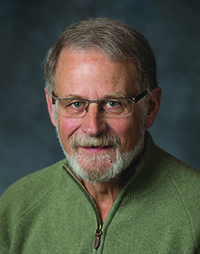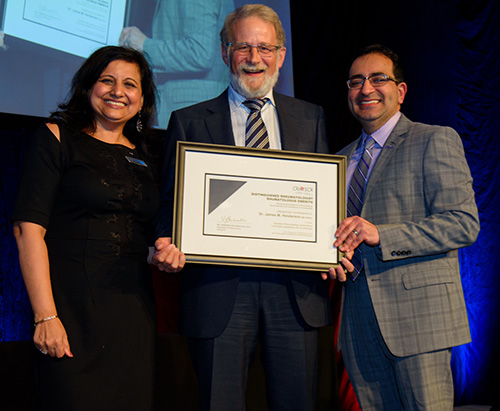Summer 2020 (Volume 30, Number 2)
The CRA's 2020 Distinguished
Rheumatologist: Dr. Jamie Henderson
Download PDF

Why did you become a rheumatologist? What or who influenced you along the way to do so?
My decision to train in rheumatology arose from a discussion with an orthopedic resident who had returned to training after two years in general practice. He indicated that his most useful consults (for himself and patients) were from rheumatologists. I wanted people to say that about my consults!
Dr. Jack Woodbury taught me the language of rheumatology and Dr. Howard Stein showed me how to function as a rheumatologist.
You have served in various leadership roles within the CRA, including as President, and now as President and Chair of the Board of The Journal of Rheumatology. You’ve also helped organize joint CRA-Mexican College of Rheumatology (MCR) meetings. Why was getting involved so important to you?
I felt that I had something to contribute to the CRA, but
really had no idea what that might be. As my involvement
got deeper and I joined the board, I thoroughly enjoyed the
interactions with the group. I took on the role of Treasurer
and that opened the door to a six-year commitment to the
executive. The time commitment was significant, but I enjoyed all the time spent.
How has your work helped shape the field of rheumatology here and elsewhere?
One of the lasting legacies was the Canadian Initiatives for Outcomes in Rheumatology cAre (CIORA). I was involved from day one with Paul Haraoui and Alf Cividino. We were able to transfer CIORA from Abbott to the CRA, and it has proven to be a good springboard for members to get acquainted with applying for and accomplishing research. I am still proud that there were many Mexican/Canadian collaborations that were established that function today.
What is the greatest professional and organizational challenge you have faced, and how did you address/overcome this challenge?
Without question the biggest undertaking was the joint meeting between Canada and Mexico. Luckily, I had Michel Zummer as part of the team, and he had many contacts as well as expertise to share (as well as some comfort in Spanish). It took a full two years to smooth out details and finally bring the meeting to fruition.
What major changes to the landscape of rheumatology have you witnessed over the course of your career?
What has impressed me the most has been the evolution of treatment options for patients with inflammatory arthritis. I started practice with gold injections, D-Penicillamine and hydroxychloroquine being the mainstays of medical options. The introduction of methotrexate gave us a better weapon, but still didn’t stop the damage. Then the biologics revolutionized treatment outcomes. My need for hospital beds vanished and patient outcomes improved significantly, and treatment options have continued to grow. Unfortunately, the cost of these new treatments now has governments and insurance companies looking over our shoulders and questioning our decisions. I found the need for paperwork justifying decisions has become overbearing.
What do you foresee as challenges to Canadian rheumatologists in the future, and what can individual rheumatologists and the CRA do to meet these challenges?
I am concerned that ultimate decision making on medications is being usurped by insurance companies and governments. Cost savings seems to be taking precedence over best outcomes. Our success in altering long-term outcomes for rheumatoid arthritis (RA) patients may be jeopardized by short-term economic decision making. Many policy decision makers may not remember the devastation that was common in the past. Unfortunately, the CRA and individual rheumatologists may appear self-serving if they protest interference in decision making. I believe that the right way to proceed may be patient groups taking a stand and demanding less outside interference in medication decisions.
What advice would you give to new and aspiring rheumatologists?
I would suggest that, when they begin practice, they consider setting aside a three-hour time slot each week that is not booked until the day before. This would allow them to be responsive to new urgent consults on a timely basis. I have found that family physicians were always relieved that patients they have serious concerns about were going to get a rapid evaluation. It helps to establish one’s reputation as a “go-to” resource when time is of the essence.
Why did you decide to retire when you did? What do you enjoy most about retirement?
I was worn out after 35 years on the front lines. Many years of my practice were during times when rheumatologists were in short supply in New Brunswick, and the pressure to see patients was relentless. Retirement has allowed me to take control of my time and pursue activities that give me pleasure (grandkids, fishing, gardening, golf, and exercise amongst others).
What do you like most about living in the Maritimes?
The Maritimes have been a wonderful place to live. Distances are short to PEI and Nova Scotia, and there is no shortage of beautiful places to visit. Housing costs are quite reasonable, and owning your own home is still quite achievable. My cottage is 15 minutes from my house! Rush hour in Fredericton lasts 15 minutes. Activities for kids were boundless and many extracurricular activities were available and close by. The quality of life has been spectacular, and the people are hospitable and friendly.
What book would you bring with you on a deserted island?
Currently I am reading Crime and Punishment. One book would not suffice. I usually have four or five books downloaded on my iPad from our local library.
You have proven that a rheumatologist from a smaller centre can be very successful as a leader in national rheumatology. Was being based in Fredericton a help or a hindrance in your career and leadership path? In what way?
The scale of our community was a plus for me. When I arrived in Fredericton there was one other rheumatologist in the province. I had to get involved in advocacy early in my career. I became comfortable in meeting with Deputy Ministers to get protected beds, approval for biologics, etc. I also got involved with the Arthritis Society as a frequent speaker and ultimately serving as President of the provincial branch. I see now that being able to have a voice early in my career gave me the comfort level to participate in national discussions and bring a local experience that resonated with others.
You were the medical leader of the Fredericton Clinic. What lessons could you apply from that work to your CRA work? What differences did you find between leading the CRA vs. leading your clinic?
I ran the business end of a privately owned clinic with 90 physicians. This helped me in communicating clearly and transparently. Physicians are very involved when their own finances are at stake. Running meetings became an art form with multiple (sometimes conflicting) viewpoints being expressed. Making sure that all viewpoints had their turn in an environment of acceptance was critical. I found that this skill set served me well when I became involved with the CRA. My first major role was as Treasurer, and understanding the overview of financial statements and being able to communicate this to members was a plus.

Dr. Henderson receiving his award from CRA President Dr. Vandana Ahluwalia and
Dr. Raheem Kherani.
Jamie Henderson, MD, FRCPC
Rheumatologist (retired)
President, The Journal of Rheumatology Fredericton, New Brunswick
|
